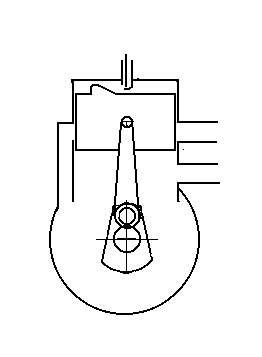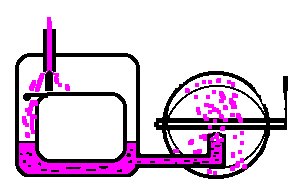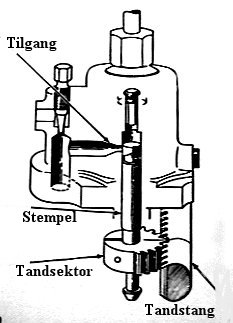 stroke-engine.
stroke-engine.
Motor tecnich
As Mechanic you know of course, how a combustion engine works. Do you
want to become familiar with the principles of an engine, try to keep up
with what is happening in the four
 stroke-engine.
stroke-engine.
Note that in a four stroke-engine is only one working stroke per 2 revolutions. The camshaft wich controls the valves, and distributor, makes therefore only one revolution for every two engine revolutions.
The individual strokes has the following names:
1. Intake
2. Compression
3. Working stroke
4. Exhaust
 For a
two-stroke engine it is different. Here, there is one working stroke per
rotation. Since it is in principle the same functions to be performed, these
may necessarily be transient or run concurrently.
For a
two-stroke engine it is different. Here, there is one working stroke per
rotation. Since it is in principle the same functions to be performed, these
may necessarily be transient or run concurrently.
A two-stroke engine is usually very simple in structure, with few moving parts, but is also available in designs which are more complicated, and may, for example. be fitted with valves arranged in different ways.
The individual strokes has the following names:
1. Compression and intake through underpressure in the crankcase
2. Incineration, as well as exhaust and fillinng of new gas/ air by means of excess pressure in the crankcase when the piston reach the bottom
Because of the simple structure is two-stroke engine developed for very small engines, and used, inter alia, to model flying and chainsaws, but is also found in such large sizes and so advanced performance that they can be used as a driving force in very large ships.
The Wankel engine may to some extent be compared with a two stroke engine, but still fall outside the rules generally used for a two stroke engine, because the Wankel engine has no less than three working strokes per rotation, and in fact only rotating parts, which makes it more like a turbine.
Gasoline or diesel
In principle, petrol and diesel engines are built the same way. The difference lies in how the fuel is ignited, and compression, which diesel engine must total at around. 1:16 to ignite fuel mixture only by compression heat, while the gasoline engines spark plugs very well could ignite gasoline/air by a compression, wich in the car's childhood was as low as about. 1:5.
Another difference is the way the fuel is carried into the combustion camber. On the diesel engine it will normally always be done through a injection pump, wich during the working stroke adds the right fuel directly into the combustion chamber, at very high pressure.
On the gasoline engine, it is usually the carburetor which controls the supply of a gasoline / air, but now is increasingly used injections pumps to lecture gasoline in the right quantities. In contrast to a diesel engine - which works perfectly with more air than needed - then the gasoline/air at a gasoline engine had to be properly balanced, and present in the combustion chamber at the time the spark must ignite the mixture.
Other engines
A hybrid between gasolin and diesel was the so-called Hesselman-engine, which looked like a diesel engine, and used diesel fuel, but because of the lower compression had to use electric ignition to ignite the fuel.
Finally, there is the glow-head engine, which also looks like a diesel engine in the building, but did not have enough compression to ignite the fuel by compression. Here are used a glow-head instead of electrical ignition. This is preheated with a blowtorch before the start-up, but then kept warm by the heat produced in the combustion during the operation.
Carburettor and injection pump
As mentioned, it is usually a carburettor which controls the supply of petrol and air-to the gasolin engine, but how does it really work.
 You
could say that the carburetor has two main functions. First, a house with
a float and needlevalve to ensure that the fuel pumps vibrant provision of
fuel is evened out, and to maintain a constant level just below the mouth
of nozle. From there, the air stream from the engine tear in the fuel in
a nearly constant relationship to the air sucked into the engine.
You
could say that the carburetor has two main functions. First, a house with
a float and needlevalve to ensure that the fuel pumps vibrant provision of
fuel is evened out, and to maintain a constant level just below the mouth
of nozle. From there, the air stream from the engine tear in the fuel in
a nearly constant relationship to the air sucked into the engine.
The other main function is to control the quantity of petrol / luftblandingen to the engine by means of a throttle, that the engine power can be increased or reduced after the desire and needs.
Even the simplest carburettor has, however, usually several features as separate idling nozles, acceleration pump to give an extra dose of gasoline when opening opening the trottle, and a device as choker, to give a fatter mix at start-up in cold state.
Although a carburettor may seem complicated, so is the injection pump, however, much more precision engineering to tight tolerances.
An injection pump at a gasoline engine does not work at as high a pressure as the pump on a diesel engine, however air and fuel are aligned to achieve optimal operating conditions.
The diesel engine is as a rule working with significant air, and is not particularly sensitive in this area. On the other hand the injection pump is working against a much higher pressure, not because of the higher compression, but caused by the sprigloaded valve in the nozzle, to ensure the complete atomization of the fuel.
The injector pump can be designed in various ways, but the most common is, that the pump elements are gathered in a house with a camshaft and a speed regulator. However, for example. the pump elements at a General Motors diesel engine are split into separate pump and injecting elements placed directly in cylinderhead for each cylinder, and moved by rockerarms in the same way as the valves. It is thus extremely easy to replace the combined pump and injecting element.
 The control
of the the capacity of injection is almost exclusively through the method
of turning plunger in the pump elements, where a tapering cutting determines
how long the injection has to last, and therefore how much power achieved.
The starting point is constant, and that means, that for a diesel engine
idling, the energy in the working stroke only lie in the first part of pistons
travel in the cylinder, while the energy at full performance will be developed
in virtually all of the pistons travel. The engine stops when the slot in
the plunger is next to the inlet opening.
The control
of the the capacity of injection is almost exclusively through the method
of turning plunger in the pump elements, where a tapering cutting determines
how long the injection has to last, and therefore how much power achieved.
The starting point is constant, and that means, that for a diesel engine
idling, the energy in the working stroke only lie in the first part of pistons
travel in the cylinder, while the energy at full performance will be developed
in virtually all of the pistons travel. The engine stops when the slot in
the plunger is next to the inlet opening.
Rotation of the plunger, and the consequent control of power, is driven by a toohted sektor at the bottom of the plunger. This is in interference with a rack which provides control of the plungers in all engine pump elements while the rack again are driven by the accelerator control or a speed regulator.
Revised marts 2 2009